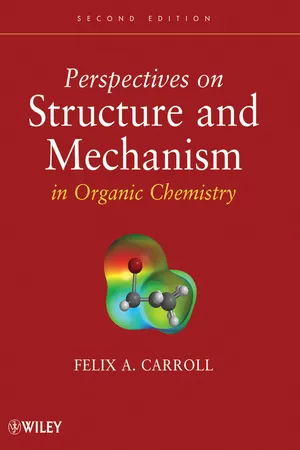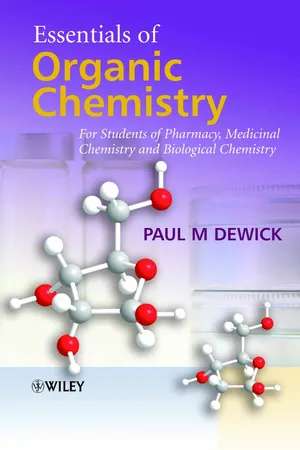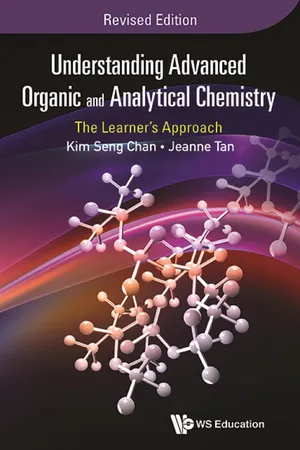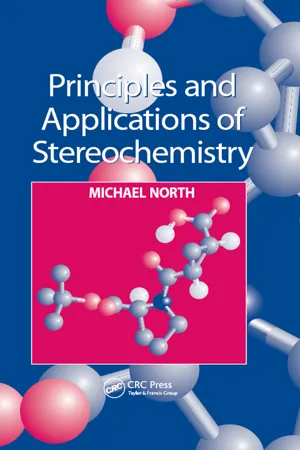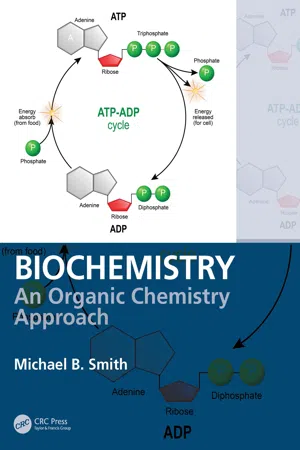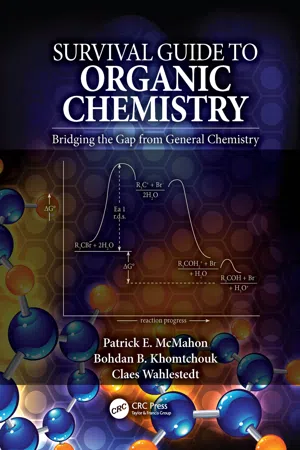Chemistry
Substitution Reaction
A substitution reaction in chemistry involves the replacement of an atom or group of atoms in a molecule with another atom or group of atoms. This process typically occurs when a reactant molecule interacts with a reagent, resulting in the substitution of one or more atoms or groups in the reactant molecule. Substitution reactions are fundamental to organic and inorganic chemistry.
Written by Perlego with AI-assistance
Related key terms
Related key terms
1 of 4
Related key terms
1 of 3
6 Key excerpts on "Substitution Reaction"
- No longer available |Learn more
- Felix A. Carroll(Author)
- 2011(Publication Date)
- Wiley(Publisher)
CHAPTER 8 Substitution Reactions 8.1 INTRODUCTION In a Substitution Reaction, an atom or group of atoms (Y) replaces another atom or group of atoms (L) in some molecular entity (RL). In shorthand notation,(8.1)Replacement of one functional group by another may occur either with or without accompanying change in the molecular framework, so R′ need not be identical to R. The general Substitution Reaction shown in equation 8.1 does not indicate the source of the electrons that are used to make the R′ –Y bond. In nucleophilic substitution, those electrons originate with Y, which is a nucleo-phile (from the Greek, philein, ‘‘to love’’).1 In electrophilic substitution, an electrophile forms a Y–R bond by using both of the electrons in the R–L bond. Leaving groups also are categorized according to the fate of the electrons that bond the leaving group to the molecule. If these electrons depart with the leaving group (as is typically the case in a nucleophilic substitution), then the leaving group is a nucleofuge (equation 8.2 ). If these electrons do not depart with the leaving group (as is typically the case in an electrophilic substitution), then that group is an electrofuge (equation 8.3 ). 2In both equations, the pair of electrons that originally comprises the R–L bond is shown as a bold pair of dots.(8.2)(8.3)It is convenient to categorize reactions with concise descriptive labels. For Substitution Reactions we often use the notation Sx M, in which the letter S indicates a Substitution Reaction. The subscript x indicates something of the mechanism, such as N for nucleophilic or E for electrophilic. M usually indicates the molecularity of the reaction, the nature of the reacting species, or additional information.3– 5 The most familiar terms for Substitution Reactions are SN 1 (for substitution nucleophilic unimolecular6 ), as shown in equation 8.4 - eBook - ePub
Essentials of Organic Chemistry
For Students of Pharmacy, Medicinal Chemistry and Biological Chemistry
- Paul M. Dewick(Author)
- 2013(Publication Date)
- Wiley(Publisher)
6
Nucleophilic reactions: nucleophilic substitution
As the term suggests, a Substitution Reaction is one in which one group is substituted for another. For nucleophilic substitution, the reagent is a suitable nucleophile and it displaces a leaving group. As we study the reactions further, we shall see that mechanistically related competing reactions, eliminations and rearrangements, also need to be considered.6.1 The SN 2 reaction: bimolecular nucleophilic substitution
The abbreviation SN 2 conveys the information ‘substitution–nucleophilic–bimolecular’. The reaction is essentially the displacement of one group, a leaving group, by another group, a nucleophile. It is a bimolecular reaction, since kinetic data indicate that two species are involved in the rate-determining step:where Nu is the nucleophile, RL the substrate containing the leaving group L, and k is the rate constant.In general terms, the reaction can be represented as belowDifferences in electronegativities (see Section 2.7) between carbon and the leaving group atom lead to bond polarity. This confers a partial positive charge on the carbon and facilitates attack of the nucleophile. As the nucleophile electrons are used to make a new bond to the carbon, electrons must be transferred away to a suitable acceptor in order to maintain carbon’s octet. The suitable acceptor is the electronegative leaving group.The nucleophile attacks from the side opposite the leaving group – electrostatic repulsion prevents attack in the region of the leaving group. This results in an inversion process for the other groups on the carbon centre under attack, rather like an umbrella turning inside out in a violent gust of wind. The process is concerted, i.e. the bond to the incoming nucleophile is made at the same time as the bond to the leaving group is being broken. As a consequence, the mechanism involves a high-energy transition state in which both nucleophile and leaving group are partially bonded, the Nu–C–L bonding is linear, and the three groups X, Y, and Z around carbon are in a planar array. This is the natural arrangement to minimize steric interactions if we wish to position five groups around an atom, and will involve three sp 2 orbitals and a p orbital as shown. The p orbital is used for the partial bonding; note that we cannot have five full bonds to a carbon atom. The energy profile for the reaction (Figure 6.1 - eBook - ePub
Understanding Advanced Organic and Analytical Chemistry
The Learner's ApproachRevised Edition
- Kim Seng Chan, Jeanne Tan;;;(Authors)
- 2016(Publication Date)
- WS EDUCATION(Publisher)
2 hybridized carbonyl carbon atom is trigonal planar. The nucleophile can attack the carbonyl carbon from either side of the plane to form a racemic mixture (or racemate) containing equal proportions of the two optically active enantiomers.If we look back at the two mechanisms that we have discussed, both types of addition reactions effectively consist of the cleavage of a pi bond within the unsaturated reactant molecule. At the end, two sigma bonds are formed with the other reactant in obtaining the final saturated product.So, we see that addition reaction can involve the attack by different species that maybe either electron-rich (nucleophilic addition) or electron-deficient (electrophilic addition). Similarly, in an organic Substitution Reaction, the attacking species may also differ. As a result, what appears on the surface to be just a simple Substitution Reaction can actually proceed via different mechanisms. Of course, the nature of the mechanism would depend on the type of reactants involved.Take, for instance, both ethane and benzene undergoing the Substitution Reaction with Br2 . The reaction conditions are totally different. This difference can be explained by looking into the mechanisms entailed.3.4.3 Free Radical Substitution Mechanism
Alkanes, although unreactive, with seemingly few reactions, do undergo substitution, but only in the presence of stringent conditions. The mechanism involved is known as the free radical Substitution Reaction, which is a chain reaction comprising of initiation, propagation and termination steps:• To initiate the chain reaction, free radicals are generated from the homolytic cleavage of the Br–Br bond in the bromine molecule. The energy needed for this process comes from either ultraviolet (UV) light or the heat supplied.• The highly reactive Br• radical then reacts with the ethane molecule, seeking out electrons through bond formation. For this to occur, a C–H bond in the ethane molecule needs to be cleaved homolytically so as to furnish the electron that is needed for covalent bond formation with the Br• - eBook - ePub
- Michael North(Author)
- 2017(Publication Date)
- Routledge(Publisher)
stereospecific reaction, one stereoisomer of the starting material produces one stereo-isomer of the product whilst another stereoisomer of the starting material gives a different stereoisomer of the product. It follows from these definitions that all stereospecific reactions are also stereoselective, but not all stereoselective reactions are stereospecific. A number of examples of both situations will be seen in the following sections.9.2 Substitution ReactionsWhen a tetravalent carbon atom is attached to a leaving group (X), a nucleophile (Y− ) may displace the leaving group as shown in Scheme 9.1 . The effect of such a reaction is that the group X is substituted by the group Y. Such a reaction is called a Substitution Reaction. Substitution Reactions of this type can only occur if the carbon atom bearing the leaving group is sp3 hybridized. If the other three groups attached to the carbon atom are all different (and different to both X and Y), then both the starting material and product will contain a stereocentre, and the Substitution Reaction will affect the configuration of this stereocentre.Scheme 9.1There are two extreme mechanisms by which such a Substitution Reaction can occur, the mechanisms being referred to as SN 2 and SN 1 respectively. In these labels, the S and N refer to substitution and nucleophilic respectively. The descriptors 1 and 2 describe the molecularity of the reaction, that is the number of molecules which are involved in the rate limiting step of the reaction. The two mechanisms have different stereochemical consequences and each will be discussed in turn.9.2.1 SN 2 reactionsIn an SN 2 reaction, the nucleophile and the electrophile (the species containing the leaving group) are both involved in the rate limiting (and only) step of the mechanism as shown in Scheme 9.2 , giving a bimolecular reaction. Thus the nucleophile (Y_ ) ‘attacks’ the carbon bearing the leaving group (X) at an angle of 180° to the C–X bond, to give in a single step the product via a trigonal bipyramidal transition state. A number of reasons have been proposed to account for the fact that the nucleophile approaches at 180° to the C–X bond. This trajectory minimizes both steric and electronic repulsions between the nucleophile and the four substituents already attached to the carbon atom. Probably more importantly, however, the unoccupied C–X σ* orbital is orientated in this direction as shown in structure9.1 - eBook - ePub
Biochemistry
An Organic Chemistry Approach
- Michael B. Smith(Author)
- 2020(Publication Date)
- CRC Press(Publisher)
3 Nucleophiles and ElectrophilesAliphatic Substitution Reactions are early examples of organic chemical reactions in a typical undergraduate organic chemistry course. Such reactions involve the reaction of nucleophilic species with an electrophilic species, and for the most part they follow first-order or second-order kinetics. There are nucleophiles that are prevalent in biochemical reactions, including alcohols, amines, and thiols. Substitution Reactions in a typical organic chemistry course involve reactions at carbon that is connected to a heteroatom moiety such as a halogen leaving group. In biochemistry the leaving group is often a phosphonate ester or another biocompatible group. Another type of nucleophilic reaction involves carbonyl compounds, including acyl addition of ketone and aldehyde moieties and acyl Substitution Reactions of carboxylic acid derivatives.This chapter will briefly review the SN 2 and SN 1 reactions and then describe nucleophiles that are common in biochemical applications and the Substitution Reactions that are common for these nucleophiles. Nucleophilic reactions require electrophilic species. Electrophiles or electrophilic substrates are common in biochemistry, including phosphonate derivatives, carbonyl compounds and imine compounds. Any discussion of typical nucleophilic reactions also requires an understanding of such electrophilic substrates. The fundamentals of both acyl addition and of acyl Substitution Reactions will be presented for carbonyl electrophilic centers and the reactions of these electrophilic centers with nucleophiles.3.1 Nucleophiles and Bimolecular Substitution (the SN 2 Reaction)The SN 2 reaction is one of the seminal reactions in a typical undergraduate organic chemistry course. The reaction of 1-bromo-3-methylbutane with sodium iodide (NaI) using acetone as a solvent gave 1-iodo-3-methylbutane, in 66% yield.1 In terms of the structural changes, the iodide ion substitutes for the bromine, producing bromide ion (Br– ). Iodide reacted as a nucleophile in the reaction at Cδ+ of the alkyl bromide, breaking the C—Br bond and transferring the electrons in that bond to bromine. In molecules that contain the C—Br bond, or indeed a C—C bond, where X is a heteroatom-containing group, the carbon will have a δ+ dipole. In other words, the carbon atom is electrophilic, and the substrate that reacts with the nucleophile is called an electrophile. The reaction of a nucleophile with an aliphatic electrophile is formally called nucleophilic aliphatic substitution , illustrated in Figure 3.1 . The displaced atom or group (e.g., chloride), departs (leaves) to become an independent ion. Displacement of chlorine leads to the chloride ion (Cl– ), but the bromide ion, iodide ion, or a sulfonate anion also correlates to X, which is referred to as a leaving group . In many biochemical reactions, the leaving group is a phosphate, —O–PO2 - eBook - ePub
Survival Guide to Organic Chemistry
Bridging the Gap from General Chemistry
- Patrick E. McMahon, Bohdan B. Khomtchouk, Claes Wahlestedt(Authors)
- 2016(Publication Date)
- CRC Press(Publisher)
Conceptual Guideto Mechanismsin OrganicChemistry12
12.1 OVERVIEW FOR UNDERSTANDING REACTION MECHANISMS
12.1.1 REACTION ELECTRON CHANGES
- A mechanism is a description of sequential bonding change steps that together provide a picture of how the complete reaction occurs(see Chapter 9).
- All bonding changes require a redistribution of electrons; therefore, mechanistic descriptions are based on the principle of following the electrons.
- Electron changes are often viewed as following electron transfers from nucleophiles to electrophiles(see Chapter 11). The nucleophile and electrophile identifications will be different for each bonding change/ combination (mechanistic step) in the sequence describing the complete reaction.
- All bonding changes require a redistribution of electrons;
- In many cases, electrophiles or nucleophiles in sequential steps may be related as different acid/base forms.
- Some mechanistic steps in a reaction may represent required proton transfers between an acid form and a base form of the specific molecule .
- Acid/base equilibria should not obscure the key bonding changes in a reaction. To keep track of acid/ base c onditions, simply add or remove protons where required .
- Many reaction mechanisms describe a general pathway that has the potential to form more than one product .
- In most cases, one product is more likely to be formed compared to the other possibilities; this is termed the major product .
- The structure of the major product in a reaction is determined either by thermodynamics (the most stable product) or by kinetics (the product formed most rapidly ).
12.1.2 SUBSTITUTION PATTERNS ON CARBON: MECHANISTIC EFFECTS
- Reacting carbons, especially electrophilic carbons, behave differently based on the types of atoms they carry as substituents; this is termed the alkyl-substitution pattern .
- Many mechanisms include one of the following high-energy species in the rate-determining step (as intermediates ):
Index pages curate the most relevant extracts from our library of academic textbooks. They’ve been created using an in-house natural language model (NLM), each adding context and meaning to key research topics.
Explore more topic indexes
Explore more topic indexes
1 of 6
Explore more topic indexes
1 of 4
